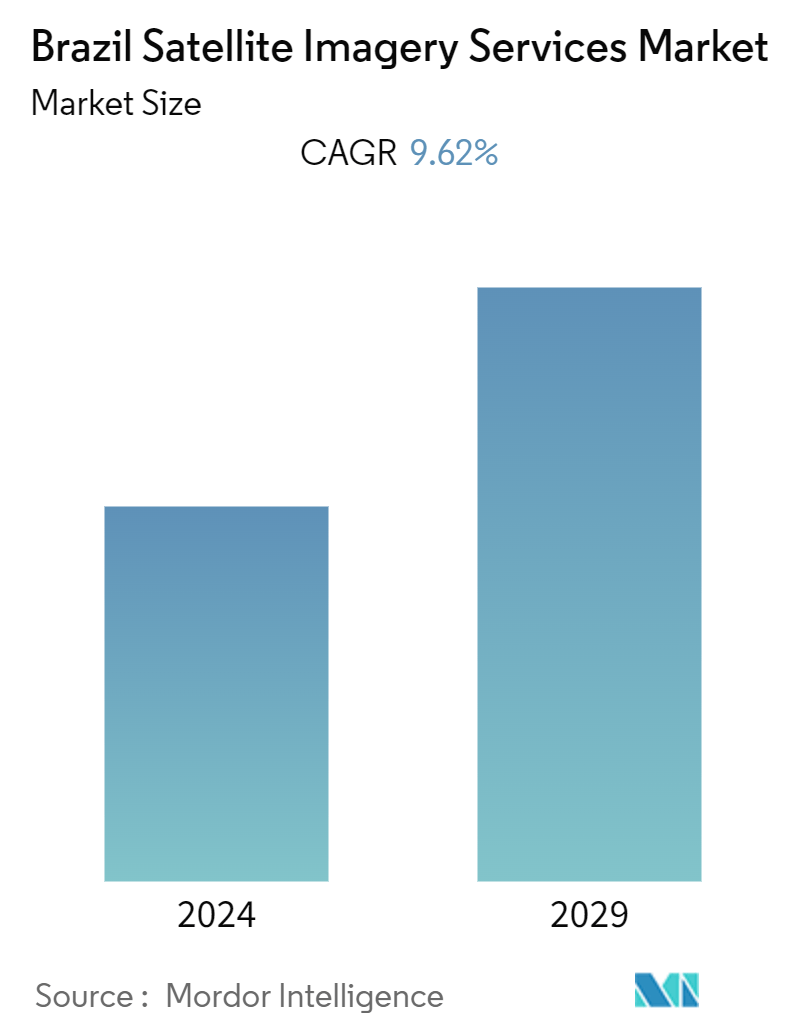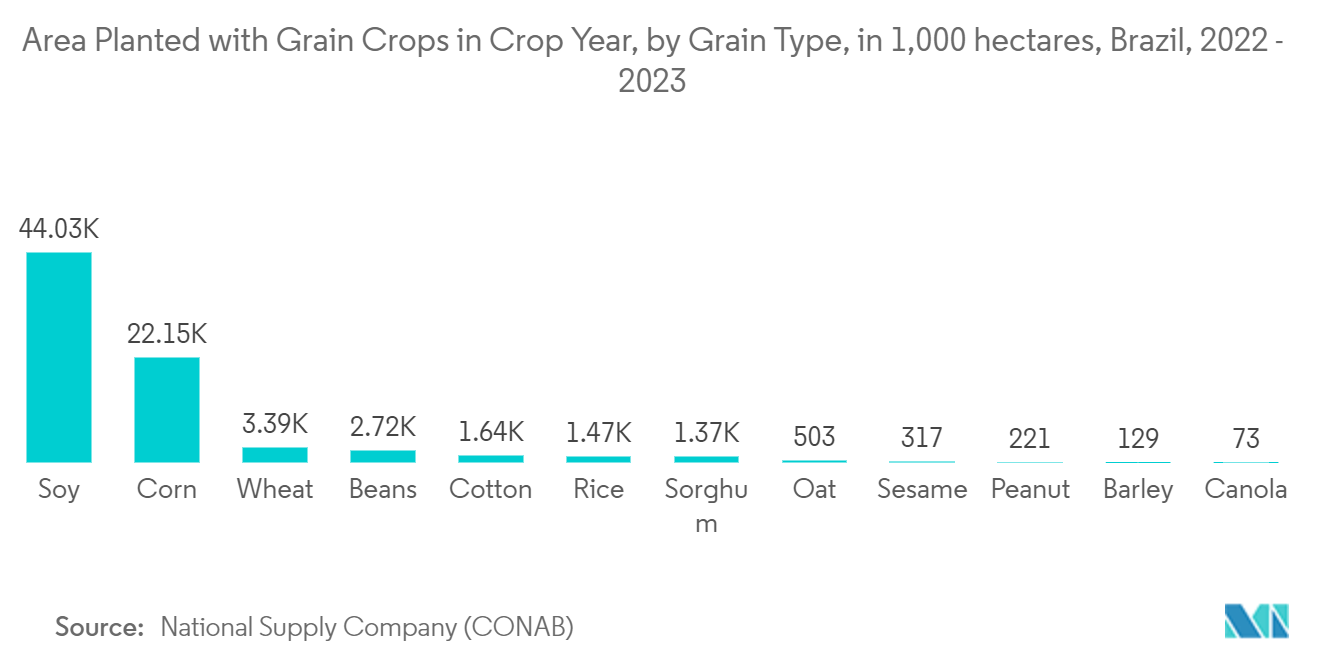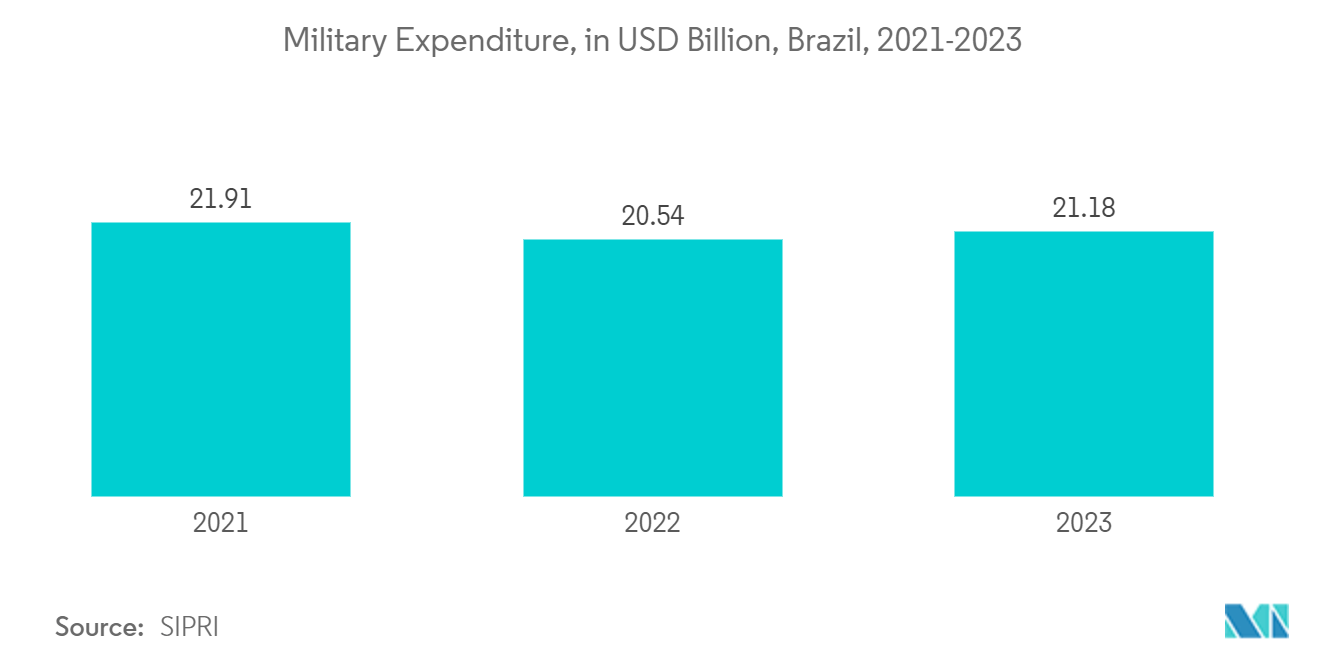Brazil Satellite Imagery Services Market Size

| Study Period | 2019 - 2029 |
| Base Year For Estimation | 2023 |
| Forecast Data Period | 2024 - 2029 |
| Historical Data Period | 2019 - 2022 |
| CAGR (2024 - 2029) | 9.62 % |
| Market Concentration | Medium |
Major Players
*Disclaimer: Major Players sorted in no particular order |
Brazil Satellite Imagery Services Market Analysis
The Brazil Satellite Imagery Services Market is expected to register a CAGR of 9.62% during the forecast period.
Satellite imagery services have emerged as a critical component in infrastructure planning and development. The government uses the information and insights obtained from satellite imagery to support government decision-making, police, civil defense operations, and geographic information systems (GIS) in general. Due to high-resolution imaging these days, data captured through satellite imagery has become mandatory. All such government plans in the future are expected to be submitted based on Satellite Imagery data.
- Disaster risk assessment and mitigation are also expected to increasingly use commercial satellite imaging solutions to improve and expedite their services. With the technology enabling 3D GIS and digital mapping, satellite imaging solutions have become an enormous enabler for better mapping. 3D models support task presentation, exploration, analysis, and management in various application domains. The 3D GIS is an effective solution for more extensive and remote locations where a manual survey is complex. Google Earth and similar map solutions have helped expedite commercial applications, prompting the vendors to build such a database and keep it updated to offer it for business applications.
- Forestry, agriculture, and mining are other similar end-user verticals that are expected to experience an increased use of these solutions over the forecast period. For instance, for the feasibility stages of mineral exploration, it becomes crucial to know about the mineral potentiality of the region considered for mineral extraction. In such scenarios, satellite remote sensing-based mapping and its integration in a GIS platform help map the potential mineral zones, saving time and resources.
- In 2022, TerraMagna, a Brazilian rural lending fintech, was represented by Foley & Lardner LLP in a USD 40 million debt and equity investment round headed by SoftBank Latin America Fund and Shift Capital. Milenio Capital, as well as other existing investors, took part in the round. TerraMagna partners with distributors and enterprises with long-standing local relationships with small and medium-sized farmers to provide loans. Satellite imagery, government statistics on environmentalism, temperature data, and information from the notary are among the data sources examined by the startup.
- On the contrary, aerial and terrestrial imaging solutions pose a significant challenge to the growth of the market studied, as they provide better resolution than satellite imaging. In addition, the inability of satellites to work in adverse weather circumstances, such as snow, fog, and cloud cover, also restricts the market growth. Aerial imaging can be carried out under cloud cover, with minor corrections applied during post-processing. This guarantees cloud-free data delivery. Due to low altitude acquisition, aerial data does not suffer from atmospheric effects, which can impact the quality of the data in satellite imagery.
Brazil Satellite Imagery Services Market Trends
Natural Resource Management is Expected to Significant Share
- The technology is being used for monitoring natural resources, such as vegetation, geological and soil analysis, land surface climatology, hydrology, and land cover change, and the generation of orthorectified digital elevation models (DEMs).
- According to the International Monetary Fund (IMF), brazil's population in 2023 is 215.16 million inhabitants. This expulsion is increasing the need for higher agricultural production and reliable crop status information. To achieve this, governments and other agricultural organizations are aiming to improve agricultural resources, especially in developing countries.
- Satellite imaging is helping farmers conduct crop forecasting and manage their agriculture production by utilizing multispectral imagery. The data generated by these methods is then used in GIS management systems to analyze and visualize agricultural environments and workflows. However, free tools, like Google Earth Pro, are helping regional farmers identify areas in fields requiring a closer analysis to decide if additional irrigation or fertilization of the crop is required.
- However, for large areas with pan-sharped vegetation indices, resolutions of 30 cm, 40 cm, or 50 cm are required. Thus, the satellite is expected to use these high- and medium-resolution satellite images, particularly for precision agriculture, with minimum commitments of 50-100 km² per area. Major applications within this segment are assessing deforestation and managing coastal lines, driven by commercial logging, forest farming, fuelwood gathering, agriculture, and pasture clearance. Furthermore, changing conditions due to urban sprawl, as well as increasing forest fragmentation, led to an increasing focus on forest productivity, reforestation, forest health, conservation of soil, water resources, and nutrient cycling.
- Satellite imaging and geographic information systems (GIS) maps can be useful for assessing and analyzing natural resources such as agriculture, forestry, and coastal management. For better study, assessment, and monitoring of natural resources, satellite imagery with spatial resolutions of up to 30 cm can be used. This technique can help with vegetation and ecosystem dynamics, hazard and disaster monitoring, geology and soil studies, land surface climatology, hydrology, land cover change, and the development of orthorectified digital elevation models (DEMs), all of which are relevant to global change.
- As per the National Supply Company (CONAB), Soybean is by far the most important grain crop in Brazil, based on planted area. During crop year 2022/2023, it was estimated that nearly 44 million hectares in the country were produced with this oilseed. The crop also accounted for almost half of the agricultural production value in Brazil in 2021. The area planted with grain crops in Brazil was forecast at around 78 million hectares in the 2022/2023 crop year. Image data is collected and translated into management systems for crop health and better production targets using high-resolution, multispectral satellite or aerial photography and artificial intelligence (AI), machine learning (ML), and computer vision (CV) algorithms.

Military and Defense is Expected to Hold Significant Share
- The satellite industry is still active in Latin America, a continent with enormous swaths of unconnected land. Many governments have invested in developing nanosatellites for scientific reasons and satellites for communication, imagery and climate monitoring. Although there is already growing in the region, most projects, including manufacturing, are carried out in collaboration with - and occasionally with funding from - other governments and foreign firms. On the other hand, brazil has yet to perfect the launch technology.
- Earth observation using high-resolution satellite imagery has long been a source of information for significant and urgent national security and defense concerns. Earth observation technologies are beneficial for monitoring land and sea borders in remote and isolated areas. It is possible to analyze vast sets of historical data and devise procedures to avoid border infractions at the regional and national levels using high-resolution satellite photos, aerial photography, and drones. Furthermore, technologies can be utilized to monitor large geographical areas and offer up-to-date information regarding infrastructure, logistics, and military installations in local conflicts. It's beneficial for assessing damage quickly in local conflict zones.
- With rising marine traffic, border security enforcement, and an increase in illicit activities and hazards at sea, it is more critical than ever to be able to properly monitor, respond, and defend our oceans and waterways. Pleiades Neo provides law enforcement agencies with a new level of maritime intelligence. The governement can now provide immediate insight for effective surveillance thanks to its 30cm resolution comprehensive imagery and multi-visit capabilities. Pleiades Neo is useful for identifying illicit activities/routes, trafficking, oil spill monitoring, and illegal fishing in maritime security and environmental applications.
- Brazil has recently launched a nanosatellite produced domestically and will be used to observe space and the atmosphere. NanoSatC-Br2 was launched into orbit on Russia's Soyuz-2 , following a postponement due to technical concerns. The satellite is now in low earth orbit (LEO). It will investigate and monitor the magnetosphere, geomagnetic field intensity, and energetic particle precipitation over Brazilian territory in real-time, among other things.Brazil is also developing its feet in Earth observation satellite systems. The country's latest observation satellite, Amazônia-1, was launched from an Indian base.
- According to SIPRI, In 2022, the government of Brazil spent more than USD 17.7 billion in the military sector. Satellite imaging allows alarm and video surveillance systems to be connected to security centers via satellite. Alarm messages and live video images can both be sent at the same time. The video images can be used for surveillance or alarm verification. Emergency voice conversations and remote control of devices such as cameras were made possible through bidirectional audio and internet-like data channels.

Brazil Satellite Imagery Services Industry Overview
The Brazil satellite imagery services market exhibits a moderate level of consolidation, featuring several key players such as ESRI, Urthecast Corp, Airbus Group Inc., L3 Harris Corporation, Galileo Group Inc., and others. These companies consistently invest in strategic partnerships and service advancements to secure a substantial share of the market. Notable recent developments in this sector include:
In March 2023, Esri unveiled a web-based mapping application based on the ArcGIS API for JavaScript. This application, known as the "Sentinel-2 Land Cover Explorer," is designed for the assessment and analysis of land-cover changes. It seamlessly integrates Esri maps, image services, spatial analysis tools, and ESA Sentinel-2 imagery at a 10-meter resolution. Importantly, this browser-based application requires no additional software or login credentials, enhancing accessibility for users.
In December 2022, TerraClass Cerrado introduced mapping solutions utilizing technologies and data sourced from the Brazil Data Cube project. TerraClass Cerrado represents a collaborative effort involving the Ministry of Agriculture, Livestock, and Food Supply (MAPA), the National Institute for Space Research (INPE), and the Brazilian Agricultural Research Corporation (Embrapa), all operating under the Ministry of Science, Technology, and Innovation (MCTI). The Brazil Data Cube (BDC) initiative, led by INPE, is focused on generating analysis-ready data and multidimensional data cubes covering the entire country. It leverages innovative technologies, including time series computation and artificial intelligence, to extract comprehensive land use and land cover information from vast data volumes, contributing to enhanced geospatial insights.
Brazil Satellite Imagery Services Market Leaders
-
ESRI
-
Urthecast Corp
-
Airbus Group Inc
-
L3 Harris corporation
-
Galileo Group Inc
*Disclaimer: Major Players sorted in no particular order

Brazil Satellite Imagery Services Market News
July 2023: NASA, the American space agency, extended its satellite technology to Brazil in support of the Amazon rainforest conservation efforts. NASA's contribution is geared towards the SERVIR Amazonia project, which aims to provide timely Earth science data to researchers and decision-makers within the Amazon region. This initiative facilitates the monitoring of environmental changes in almost real-time, aiding in the prediction of climate-related threats such as deforestation and food insecurity. Additionally, it equips emergency responders with crucial data during natural disasters.
November 2022: In a collaborative effort between Google and the Geological Service of Brazil (SGB), unveiled in Florianópolis, Santa Catarina state, a system was developed to issue river flood alerts throughout the country. This innovative system integrates river water level data, meteorological indicators, and satellite imagery to provide real-time information to residents in over 60 locations. In the upcoming months, the alerts and forecasts are expected to expand their coverage to more regions. Users can access river condition alerts and forecasts seamlessly while using Google Maps, conducting search queries, or utilizing the new platform, FloodHub.
Brazil Satellite Imagery Services Market Report - Table of Contents
1. INTRODUCTION
- 1.1 Study Assumptions and Market Definition
- 1.2 Scope of the Study
2. RESEARCH METHODOLOGY
3. EXECUTIVE SUMMARY
4. MARKET INSIGHTS
- 4.1 Market Overview
-
4.2 Industry Attractiveness - Porter's Five Forces Analysis
- 4.2.1 Bargaining Power of Buyers
- 4.2.2 Bargaining Power of Suppliers
- 4.2.3 Threat of New Entrants
- 4.2.4 Threat of Substitutes
- 4.2.5 Intensity of Competitive Rivalry
- 4.3 Industry Value Chain Analysis
- 4.4 Assessment of the Impact of COVID-19 on the Market
5. MARKET DYNAMICS
-
5.1 Market Drivers
- 5.1.1 Increasing Adoption of Location-based Services
- 5.1.2 Satellite data usage is increasing
-
5.2 Market Restraints
- 5.2.1 High-resolution Images Offered by Other Imaging Technologies
6. MARKET SEGMENTATION
-
6.1 By Application
- 6.1.1 Geospatial Data Acquisition and Mapping
- 6.1.2 Natural Resource Management
- 6.1.3 Surveillance and Security
- 6.1.4 Conservation and Research
- 6.1.5 Disaster Management
- 6.1.6 Intelligence
-
6.2 By End-User
- 6.2.1 Government
- 6.2.2 Construction
- 6.2.3 Transportation and Logistics
- 6.2.4 Military and Defense
- 6.2.5 Forestry and Agriculture
- 6.2.6 Other End-Users
7. COMPETITIVE LANDSCAPE
-
7.1 Company Profiles
- 7.1.1 ESRI
- 7.1.2 Urthecast Corp
- 7.1.3 Airbus Group Inc
- 7.1.4 L3 Harris corporation
- 7.1.5 Galileo Group Inc
- 7.1.6 Satellogic
- 7.1.7 Trimble Navigation
- 7.1.8 Digital globe Inc (Maxar Technologies)
- *List Not Exhaustive
8. INVESTMENT ANALYSIS
9. MARKET OPPORTUNITIES AND FUTURE TRENDS
** Subject To AvailablityBrazil Satellite Imagery Services Industry Segmentation
Satellite imagery refers to images of the Earth taken from satellites orbiting the planet. These satellites are equipped with various sensors for detecting visible light, infrared light, microwave radiation, and more to craft high-resolution images. These images combine to create visual representations of the Earth, providing new perspectives on climate, geography, and manmade structures.
The Brazil satellite imagery services market is segmented by application (geospatial data acquisition and mapping, natural resource management, surveillance and security, conservation and research, disaster management, and intelligence) and end-user (government, construction, transportation and logistics, military and defense, forestry and agriculture, and other end-users).
The market sizes and forecasts are provided in terms of value USD for all the above segments.
| By Application | Geospatial Data Acquisition and Mapping |
| Natural Resource Management | |
| Surveillance and Security | |
| Conservation and Research | |
| Disaster Management | |
| Intelligence | |
| By End-User | Government |
| Construction | |
| Transportation and Logistics | |
| Military and Defense | |
| Forestry and Agriculture | |
| Other End-Users |
Brazil Satellite Imagery Services Market Research Faqs
What is the current Brazil Satellite Imagery Services Market size?
The Brazil Satellite Imagery Services Market is projected to register a CAGR of 9.62% during the forecast period (2024-2029)
Who are the key players in Brazil Satellite Imagery Services Market?
ESRI, Urthecast Corp, Airbus Group Inc, L3 Harris corporation and Galileo Group Inc are the major companies operating in the Brazil Satellite Imagery Services Market.
What years does this Brazil Satellite Imagery Services Market cover?
The report covers the Brazil Satellite Imagery Services Market historical market size for years: 2019, 2020, 2021, 2022 and 2023. The report also forecasts the Brazil Satellite Imagery Services Market size for years: 2024, 2025, 2026, 2027, 2028 and 2029.
Brazil Satellite Imagery Services Industry Report
Statistics for the 2024 Brazil Satellite Imagery Services market share, size and revenue growth rate, created by Mordor Intelligence™ Industry Reports. Brazil Satellite Imagery Services analysis includes a market forecast outlook to for 2024 to (2024to2029 and historical overview. Get a sample of this industry analysis as a free report PDF download.



